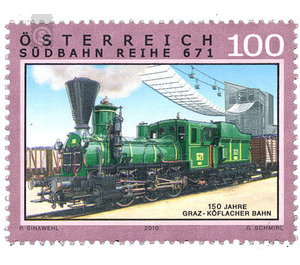150 years - Austria / II. Republic of Austria 2010 - 100 Euro Cent
Theme: Traffic, Transportation & Mobility
| Country | Austria / II. Republic of Austria |
| Issue Date | 2010 |
| Face Value | 100.00 |
| Edition Issued | 300,000 |
| Printing Type | Typography |
| Stamp Type | Commemorative |
| Item Type | Stamp |
| Chronological Issue Number | 2197 |
| Chronological Chapter | OOS-OE2 |
| SID | 977396 |
| In 64 Wishlists | |
The Graz-Köflacher Bahn and Busbetrieb GmbH (GKB) opens up the western periphery of the city of Graz and the districts of western Styria with two railway lines and 27 bus lines. Today it is the main mode of public transport in the region and a major partner of local freight companies. The route length is 91 kilometers with 31 stations, the annual transport service covers about three million passengers and more than 500,000 tons of goods. History: After an already planned in 1851 horse railway from Köflach to Graz failed in the execution, received the then operating "Voitsberg-Köflach-Lankowitzer coal industry" on August 26, 1855 imperial privilege for the construction and operation of a "locomotive railway" from Köflach to Graz. For this reason, the trades union became a joint stock company called "k. k. Privileged Graz-Köflacher Railway and Mining Company "transformed; On 16 January 1856, this held its first General Assembly in Vienna. The "starting signal" for the construction of the Köflacherbahn was given by none other than Archduke Johann - and it was he, too, who personally determined the route. No wonder, the Archduke was the great promoter and co-planner of the Südbahn and as owner of coal mines in Köflach and a sheet rolling mill in western Styria also personally very interested in this rail connection. On June 22, 1859, the operation on the route Graz-Köflach was initially provisionally recorded, the beginning of the regular passenger traffic was finally on April 3, 1860, the freight traffic a short time later, on 1 November of the same year. From 1878 to 1924, GKB did not operate the business itself, but transferred it to the Austrian Southern Railway Company. In 1952, the route between Oberdorf and Köflach was relocated because of the coal mining and the 241 meter long Rosental Tunnel was built. In the second half of the 20th century, the gradual decline of coal mining and growing mobility reoriented passenger transport. Finally, in the 1980s GKB's tracks became a meeting point for many railway enthusiasts, as GKB was one of the last rail authorities in Austria to use steam locomotives in shunting and, in some cases, even in the line service. Apropos: The brand image shows the legendary steam locomotive 671 from the Südbahn series, built in 1860 - one of the oldest operational and the longest-serving steam locomotive in the world!


